If you’re hoping I’ll give you a basic answer like Send all your emails out on Tuesday before 10:00 am, you’re headed for disappointment.
While I’d love to keep things short and sweet, following a general rule with zero data from your audience to back it up makes for a crummy email strategy.
There are data-backed guidelines you can follow to get the highest open rate in different markets, like this:[*]
- Entrepreneurs & Workaholics: Saturday at 10am
- B2B (Normal People Who Work 9-5): Saturday at 10am
- B2C (Consumers): Saturday at 12am
That might be enough for you, if you’re starting out and only have a small list of no more than 2,000 subscribers.
But if you’re more advanced, you’ll want to find the best time to send for YOUR unique audience.
Inside this guide I’m going to show you:
- The best time to send based on your type of email (i.e. educational vs promotional).
- How to catch your subscribers when they’re (mostly) free from distractions.
- An easy way to a/b test your way to the perfect send time.
If you’d like a fill-in-the-blank worksheet you can use to answer a handful of questions to find the best time to send email for your business, click the button below to download it now.
Best Time to Send Email: Consider Your Subscribers
Best practices aside, you need to remember who you’re really sending your emails to.
Is your email audience top executives who’ve already completed what most consider to be a full day by 6:00am?
Or are you sending emails to stay-at-home moms, college kids, and small business owners?
Knowing this makes a huge difference in your email scheduling.
If you’re only sending your emails based off general data — or worse, your work schedule — you’re not going to make any progress.
Grab your buyer avatar and consider how your customer spends their days to get a better idea of their least distracted times.
In the first case, top executives like Tim Cook reportedly read their emails as early as 3:45am! Sending an email to this crowd at 2:00am may help you beat the rush.[*]
While new moms and college kids might also be up at this time, they’re probably not in the ideal frame of mind you’re hoping to reach.
It’s also essential that you consider your avatar’s age.
MailChimp’s report shows that the age of your subscriber plays a large part in how likely they are to open their emails around a certain time every day.[*]
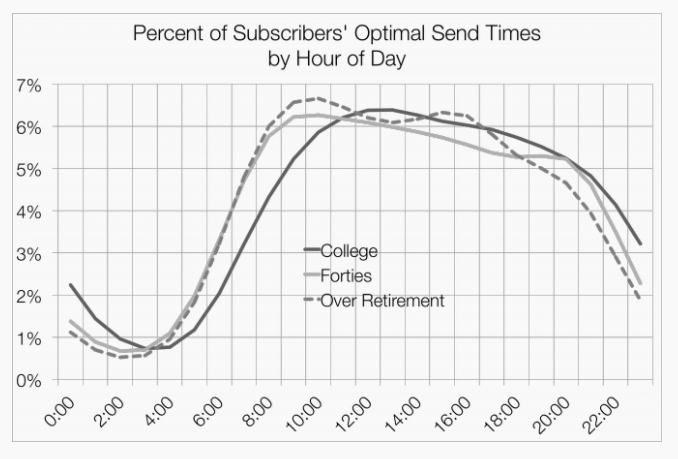
You’re probably not surprised to learn that:
- Most college kids open their emails between noon and 2pm
- Open rates for older subscribers peak between 9am and 11am
Your avatar’s occupation also has an impact on when they’ll open emails.
Following that same MailChimp report, check out how email open rates vary across professional occupations in this chart:

Open rates for lawyers peak between the 9am to noon time slot while bartenders can’t be bothered until lunchtime. And neonatal nurses have spikes and dips in their email habits depending on their shift for the day.
So if you’re going by general data about when the “average” person opens their emails, you’ll see charts like this one:
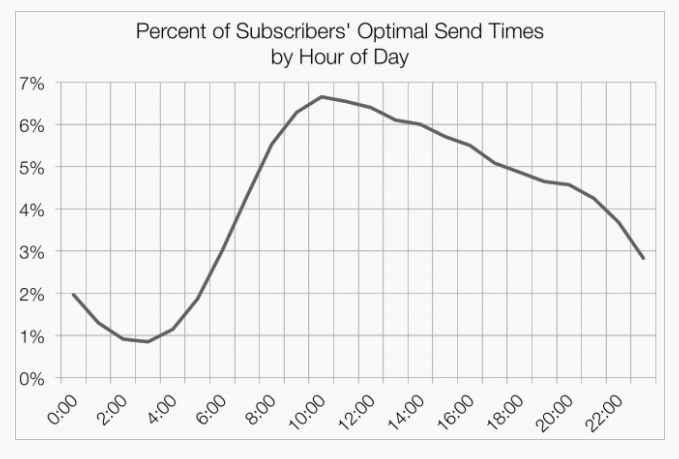
According to this squiggle, the best generic time to send your emails is between 10am – 12pm.
This graph by KISSmetrics does a better job of dissecting a generic 24-hour timeframe for sending emails:[*]
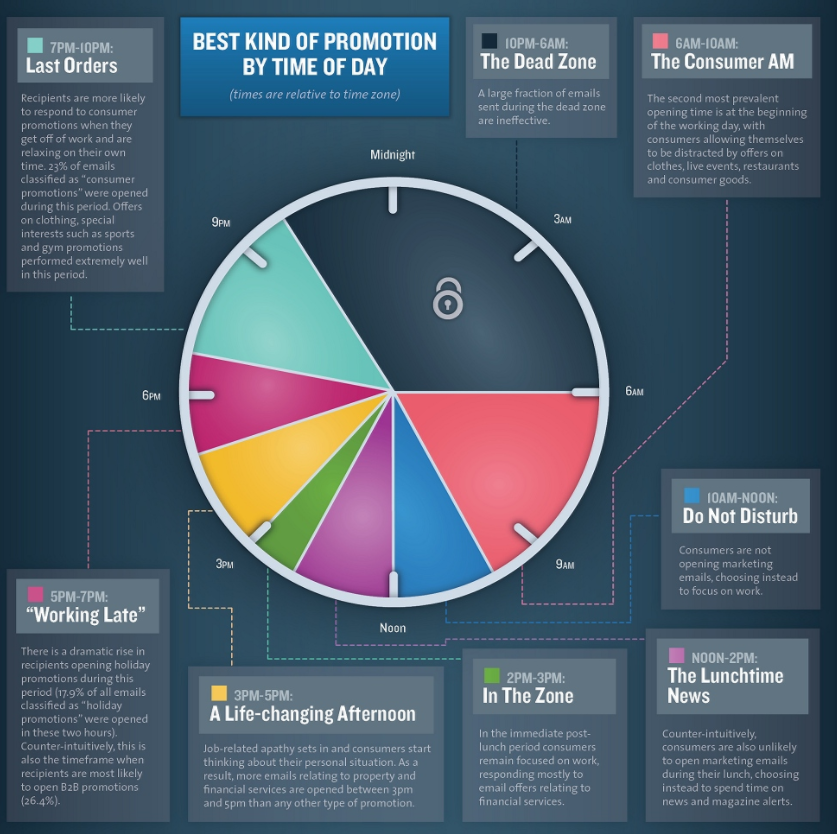
Essentially, they discovered that:
- 6am – 10am is when readers respond best to offers for “clothes, live events, restaurants, and consumer goods.”
- 10am – 3pm is an email lull because most people are busy working or catching up on the latest news and gossip.
- During the 3pm – 5pm time slot, readers open emails connected to property and financial services more than any other.
- From 5pm – 10pm, emails with promotional sales and specials lead to more opens.
The last time-sensitive point to think about when it comes to your audience is their timezone.
If you’re sending an email at the right time — but it’s in your timezone — it’s going to get buried under all the other emails being delivered according to your subscriber’s clock.
Some email providers give you the option of sending your emails at a certain time in every timezone. Check to see if yours has this feature and start utilizing it right away.
The key takeaway here: Consider your audience first.
- What does a typical day look like for them?
- What time(s) do they have a break in their action?
- Are they more likely to read emails before the sun comes up or as it’s going down?
- Is there a time where they are the least distracted?
Use your research as a general guide to brainstorm a list of times that might work with your audience.
With options in hand, you need to A/B test those times to find the sweet spot for your audience. I’ll dive into this more later on.
Until then, you also need to figure out which day to send your emails.
Good thing there’s even more data we can discuss about this next.
Best Day to Send Emails
Sending your emails at the right time won’t do much good for your stats if you’re delivering them on the wrong day of the week.
In this GetResponse study, researchers found that emails sent on Tuesdays and Fridays earned the highest open rates (19.9% and 19.6%, respectively).[*]
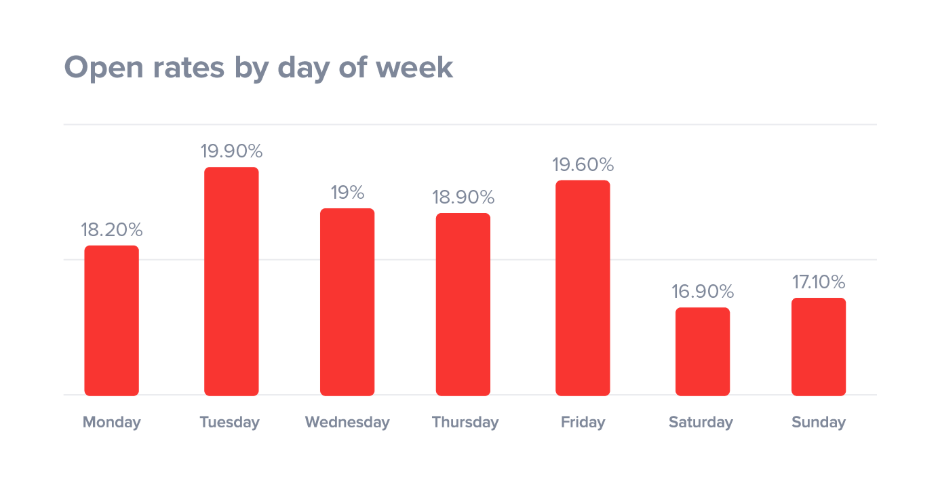
Weekend emails make sense for certain industries and circumstances.
If your message has anything to do with making your subscriber’s weekend better, they’ll be more interested to hear what you have to say.
So arts and crafts, outdoor/indoor hobbies and activities, and event messages work on Fridays and Saturdays.
I talk about how Michaels (a craft paint store) does a stellar job of this in this guide on email marketing examples. To get their readers to take action over the weekend, Michaels sent out this email giving readers the inspiration and tools they need to get started.

The data about Tuesdays doesn’t need quite as much explaining.
Most of us are over the Monday madness and have settled into our weeks a bit by Tuesday, so we have more time to read emails that come our way.
To build on this idea, researchers from a Campaigner study compared open rates from the first and second halves of the year and discovered:
- Tuesdays and Wednesdays had the same open rates (10.7%) in the first half of the year
- But during the second half, Tuesdays became the clear winner (10.6%), followed by Mondays (10.1%)
- Weekends (and Thursdays) showed the lowest open rates

Seems like Tuesday is our clear winner, right?
Not so fast.
Wordstream analyzed their own stats and found that when their newsletters were sent out at 8:00am on Thursday, they saw the highest open rates (25%)![*]
Plus, they uncovered that Tuesday and Wednesday emails sent at this same time came back with open rates under 5%. Yikes!
These findings go against everything we’ve seen so far.
If the Wordstream team simply went by the graphs above, their emails would never be opened and all of their messages would be lost in their subscriber's email landfill.
In this last and most recent study from Smart Insights, researchers analyzed the open rates for B2B and B2C emails.[*]
They discovered that B2B emails sent to Entrepreneurs and Workaholics during the weekends had the highest open rates:

But B2B emails to normal 9-5 office workers floundered during the weekends as these cats typically go MIA to spend time with family when it comes to checking them.
Weekdays performed best with this crowd, particularly those sent out on Thursday, Wednesday, or Tuesday (in that order).
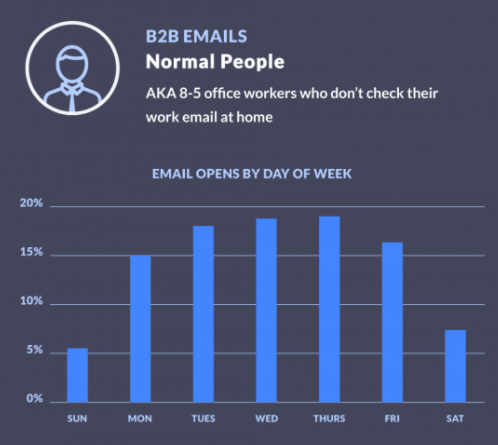
B2C emails in this research, on the other hand, showed success when they were delivered on Friday, Monday, Sunday, and Saturday (but their open rates didn’t differ by much).
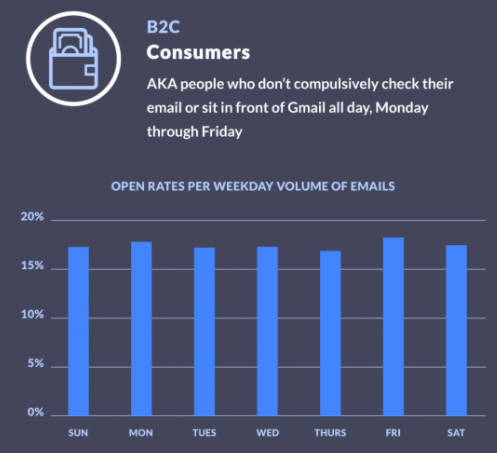
Despite all this, Smart Insights concluded that Tuesdays at 10:00am seems to be the best time to send emails.
Again, learn if this time makes sense for your audience before using it as a hard and fast rule. No one knows the goals of your email strategy better than you do.
So let’s put that knowledge to good use and find your own best time to connect with your subscribers.
What are You Trying to Accomplish Here?
Before you run off to write your next email, figure out why you’re sending one in the first place.
- Are you trying to educate your subscribers with a new article or podcast episode?
- Do you want your subscribers to opt in for your new webinar or course?
- Or are you looking to drive them to one of your partners or sponsors?
Are you trying to educate your subscribers with a new article or podcast episode?
Do you want your subscribers to opt in for your new webinar or course?
Or are you looking to drive them to one of your partners or sponsors?
Choose one focus for your emails.
Not only does this help you create copy that converts, it also helps you hone in on when to send your emails.
#1: Looking for a Response From Your Audience?
Send emails like these earlier in the day or in the early evening, as Smart Insights found, reply rates are highest at these times:[*]
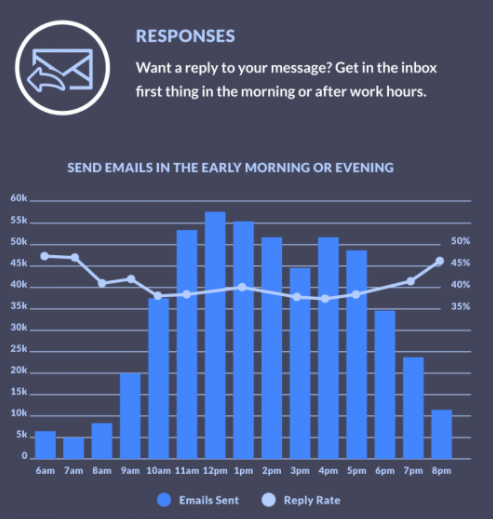
Here’s how they broke these stats down based on those three audience groups we discussed earlier:

By carefully selecting these times, you’ll have a better chance of catching your reader when they’re focused and have time to respond.
GetResponse research also uncovered one more important point to consider here: How fast are emails opened once they’re sent?
According to their data, 23.8% of emails are opened within the first hour after being delivered.[*]
Here’s the bad news: your email has less than a 1% chance of being opened after 24 hours.
This is why it’s so essential to narrow down the right time and day for your audience.
Like a chain reaction, increase your open rates and you’ll also increase your transaction rates as I’ll show you next.
#2: Do You Want to Increase Your Transactions?
Experian researchers found that transaction rates for emails sent between 4:00am and 8:00am could be as high as 33%.[*]
Could this work for your audience?
This small window of time might inspire early-risers to make a purchase, but emails sent after work might perform better when your audience is looking to decompress from a long, stressful day at the office with retail therapy.
The only way to know for certain is to perform A/B tests with your subscribers.
Before I get to that, you have to look out for one more thing to increase your open rates.
#3: Is This Email Educational or Action-Oriented?
Another report from Smart Insights shows us that informative and educational emails should be sent during the beginning of the week for optimal results.[*]
The idea here is that subscribers are looking for help and are motivated earlier rather than later on in the week:
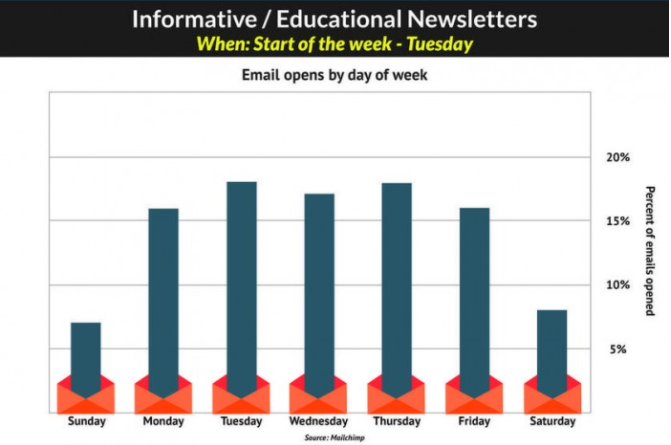
So an email for educational content should perform better on Tuesday than one sent Saturday, for example.
Yet this same research found that if you want your subscribers to take action, it’s better to send these emails towards the end of the week.
Friday stands out the most in terms of performance.
Here, subscribers have more time to read your emails so they’ll also have more time to take action when they feel compelled by your copy.
Now that you’re equipped with the knowledge bombs behind the research, it’s time to start narrowing down the best times and days to send your killer emails.
Find the Best Times & Days to Send Emails
First, consider how many emails you plan on sending each week.
If you’re pairing an educational email with a sales email every week, consider sending those out in that specific order. Give your subscribers at least one or two buffer days in between.
You could send (and test) your educational emails on Tuesday or Wednesday and your promotional ones on Thursday or Friday, for instance.
If you’re sending out one email each week, play around with (and test!) whether a Tuesday, Wednesday, or Thursday (or any other day really) works best for your audience.
Once you have an idea of how many emails you’ll be sending each week, consider your audience’s schedule to find the perfect time to send them.
Choose a few time slots and days of the week to begin your A/B testing and record everything you find.
Use A/B Testing to Narrow Down Your Send Times
For all you beginners, A/B testing is not as scary as it sounds. It just means that you’ll send a portion of your list a slightly different variation (B) of your original email (A).
So if you’re testing out the best day to send your articles, you could send the same email to half your subscribers on Tuesday and the other half Wednesday.
On Thursday morning, compare the stats from both attempts to see which day performed better with your audience.
You could also test out times in a similar manner.
If you know your emails perform better on Tuesdays, test whether they crush it early in the morning or later in the evening.
It’s important that you only change one variable at a time (such as the day or time, but not both) so you can draw objective conclusions as to why one email performed better.
After A/B testing their send times alone, MailChimp increased their open rates by 9.3%.
They also improved their click through rates by 22.6%.
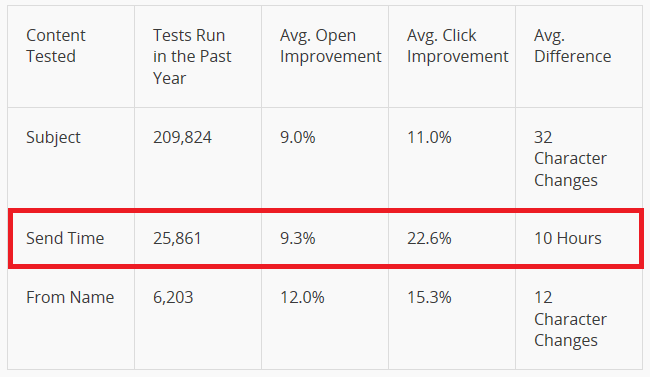
After a few rounds of A/B testing, you’ll have a much better understanding of your audience and easily do the same.
If you’re not learning anything valuable from A/B testing, these 12 reasons for your low open rates could be to blame. If those aren’t in order, it won’t matter what time or day you send your emails.
Stop Using General Times & Find What Works for Your Subscribers
Though it may seem like it’ll take a long time to replicate the findings we discussed for your own subscribers, it’s time well spent researching if you can boost your email open rates.
If you’re working with a small or new email list, start out with the general timing guidelines we learned from the experts today. Play around with different send times and days as your list and your understanding of your subscribers grows.
Continue to change one variable every week, A/B test, and tweak your process to discover your sweet spot for high open, click through, and transaction rates.
And before you go, don’t forget to grab the free worksheet I put together. Inside you can answer the fill-in-the-blank questions I made to narrow down the best time to send emails to YOUR subscribers.
P.S. Want to learn the 10 growth hacks we’ve used to grow our email list to over 100,000 subscribers, so you can build a bigger list to send emails to? Click here for our most actionable growth hacking ideas to grow your email list and traffic.










Add A Comment
VIEW THE COMMENTS